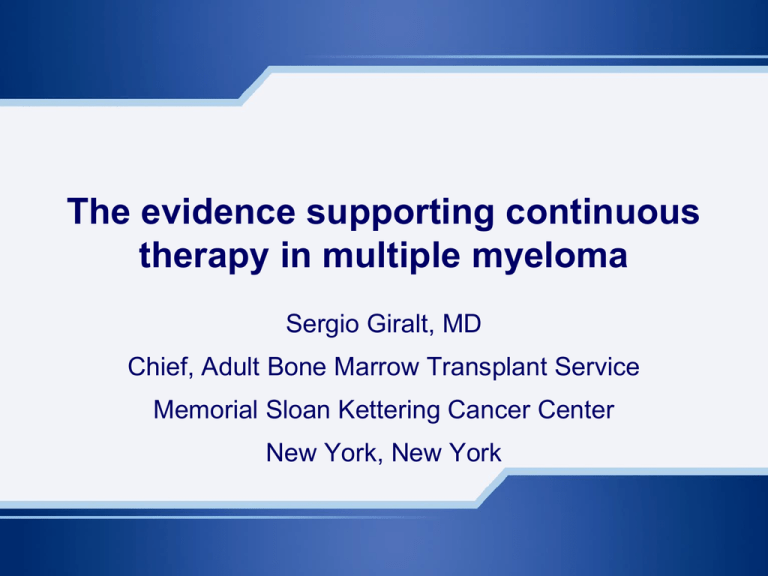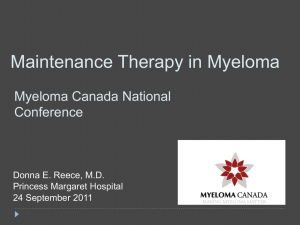Continuous treatment in multiple myeloma – the future
advertisement

The evidence supporting continuous therapy in multiple myeloma Sergio Giralt, MD Chief, Adult Bone Marrow Transplant Service Memorial Sloan Kettering Cancer Center New York, New York Why Maintenance Therapy? • Induction therapy followed by autologous SCT alone will cytoreduce but not cure most Multiple Myeloma patients • Can maintenance therapy: – prevent or delay disease progression? – convert partial responses to complete responses? – improve overall survival? • Problems with maintenance therapy – Everybody gets the drug not everybody gets the benefit. – You “burn” an effective drug. – Treatment fatigue • What defines an ideal maintenance strategy? – Significantly improved outcomes with minimal side effects and preservation of response to salvage. Maintenance Therapy Philosophical Perspective • Pros • Cons • Increases remission duration. • Exposes all patients to the side effects of prolonged treatment. • Maintains minimal disease burden preventing end organ damage. • Can result in resistant clones. • Targets “tumor cells” that leave “dormancy phase”. • Late effects of long-term therapy. • May further decrease tumor burden post primary therapy. • Cost Common wisdom dictates that PFS by itself may not justify continuous therapy for all patients with a specific disease. Either a survival or QOL benefit needs to be garnered when comparing continuous therapy to therapy upon progression. The question is made even more difficult if the issue of preemptive (i.e. early intervention) is included. Rationale for continuous treatment in the era of IMID’s and Proteosome Inhibitors • Primary therapy even with high dose therapy results in CR in less than 50% of patients. • Longer treatment can result in better disease control and may be associated with – prolonged duration of response – increased depth of response • Survival benefit??? • Use of different mechanisms of action (MoAs) of novel agents • Tolerability of novel agents allows for longer-term treatment Potential risks of continuous treatment in the era of IMID’s and Proteosome Inhibitors • Adverse events related to long-term treatment – reduced quality of life – impact on subsequent therapeutic options – second primary malignancies? • Reduced survival after relapse – selection of resistant clones – availability of non-cross-reacting agents Historical Perspective • Long term alkylator therapy associated with higher risk of 2ry MDS/AML • Interferon maintenance multiple randomized trials marginal benefit in PFS no survival benefit. Poor compliance. • Long term steroid therapy potentially beneficial Upgrade in MRD negativity with consolidation: GIMEMA study • VTD compared with TD consolidation (x 2 cycles starting within 3 months post ASCT) on minimal residual disease (MRD) in MM patients treated in the phase III GIMEMA trial • Results (VTD, n = 35; TD, n = 32) – upgrade in MRD-negativity from 43% to 67% for VTD vs upgrade from 38% to 52% with TD (p = 0.05 for 67% vs 52%) – PCR bone marrow analysis showed a median 5 log reduction in tumour burden with VTD vs a 1 log reduction with TD (p = 0.05) Terragna, et al. Blood. 2010;116:[abstract 861]. Impact of thalidomide based maintenance post-ASCT Patients (N) Duration of treatment CR + VGPR (%) EFS or PFS (%) OS (%) TT21,2 668 Double ASCT Thal vs no maintenance until progression 64 vs 43* (CR only) p < 0.001 52 vs 41 (5 years) p = 0.0005 57 vs 44 (8 year) p = 0.09 Sign in cyto abnormalities IFM 99-023 597 Double ASCT Pam + Thal vs Pam vs none until progression 67 vs 57 vs 55 52 vs 37 vs 36 (3 years) p < 0.009 87 vs 74 vs 77 (4 years) p < 0.04 243 Single ASCT Pred + Thal vs Pred, 12 months 63 vs 40 42 vs 23 (3 years) p < 0.001 86 vs 75 (3 years) p = 0.004 Spencer4 Morgan5 • 6/6 trials showed a significant benefit on PFS p = 0.03 • 2/6 trials showed a significant benefit on OS + 1/6 showed a significantNAOS benefit in patients Thal vs no maintenance HR: 1.36; 95% CI: 820 until progression 1.15–1.61 with cytogenetic abnormalities p < 0.001 NS Lokhorst6 556 Double or single ASCT Thal vs alpha-interferon until progression 66 vs 54 p = 0.005 34 vs 22 p < 0.001 73 vs 60 p = 0.77 Stewart7 332 Single ASCT Thal + Pred vs observation until progression Not reported 28 months vs 17 months p < 0.0001 Median not reached vs 5 years P = 0.18 1. Barlogie B, et al. Blood. 2008;112:3115-21. 2. Barlogie B, et al. J Clin Oncol. 2010;28:3023-7. 3. Attal M, et al. Blood. 2006;108:3289-94. 4. Spencer A, et al. J Clin Oncol. 2009;27:1788-93. 5. Morgan GJ, et al. Blood. 2010;116:[623]. 6. Lokhorst HM, et al. Blood. 2010;115:1113-20. 7. Stewart AK, et al. Blood. 2010;116:[39]. Impact of bortezomib and thalidomide maintenance post-ASCT HOVON-65/GMMG-HD4 trial 100 80 VAD-thalidomide PAD-bortezomib Years (%) 78 71 60 50 40 38 42 48 30 20 16 0 CR/nCR premaintenance CR/nCR postmaintenance PFS at 3 years OS at 3 years * Patients received one (HOVON) or two (GMMG) treatments with high-dose melphalan (HDM) with ASCT. Sonneveld P, et al. Blood. 2010;116:[abstract 40]. Tales of Two Cases Case 1 Case 2 • 55 yo female presents with asymptomatic anemia of 10 gm/dl and total serum protein 10 gm/lt • 55 yo female presents with asymptomatic anemia of 10 gm/dl and total serum protein 10 gm/lt • Work up reveals – 30 % plasma cells – Cytogenetic diploid – IgA kappa peak of 3.2 • Work up reveals – 30 % plasma cells – Cytogenetic t 4,14 – IgA kappa peak of 3.2 – Beta 2 microglobulin of 3.0 – Beta 2 microglobulin of 3.0 • Receives 4 cycles of Bortezomib /Thal/Dex • Receives 4 cycles of Bortezomib /Thal/Dex • Followed by Auto SCT on Day 60 documented stringent CR • Followed by Auto SCT on Day 60 documented paraprotein peak of 0.4 gm/dl Phase III IFM 2005-02: Lenalidomide as Consolidation/Maintenance Post-ASCT Consolidation N = 614 First-line ASCT Lenalidomide: 25 mg/d Days 1–21/month 2 months Lenalidomide: 10–15 mg/d until relapse ≤ 6 months No PD < 65 years Lenalidomide: 25 mg/d Days 1–21/month 2 months Primary end point: PFS Attal et al, 2009. Placebo until relapse IFM 2005-02 : PFS from randomization . Arm A N=307 Arm B N=307 Progression or Death 143 (47%) 77 (25%) Median PFS (m) 24 (21-27) NA 34% 68% 3-year post rando PFS Hazard Ratio 1 0.46 P < 107 PFS according to Response PreConsolidation VGPR or CR 1.00 Len 0.75 0.75 1.00 PR or SD 0.50 0.50 Len Placebo 0.25 0.25 Placebo p<10-5 0.00 0.00 p=0.001 0 6 12 18 Placebo 24 30 Revlimid HR= 0.37 - CI 95% [0.25-0.58] 36 0 6 12 18 Placebo 24 30 Revlimid HR= 0.54 - CI 95% [0.37-0.78] 36 IFM 2005 02 : Prognostic factors for PFS Univariate analysis p Age NS ISS (I / II + III) NS Beta-2 m (<=3 / >3) 0.01 Del 13 (Yes / No) 0.06 Induction (VAD / Vel-Dex / Others) 0.04 Response after ASCT (VGPR / no) 0.009 Response after consolidation (VGPR / no) 0.0004 Treatment Arm (A / B) < 10-7 Multivariate analysis p Treatment Arm (A / B) 0.00001 Response after consolidation (VGPR / no) 0.004 Grade 3-4 Adverse Events during Maintenance AEs (grade 4) Arm A Arm B Anemia 0% 3% (2%) Thrombocytopenia 3% 8% (3%) 6% (1%) 31% (7%) Febrile Neutropenia 0% 0.1% Infections 4% 8% 0.3% 0.6% 1% 4% Fatigue 0.6% 2% Peripheral Neuropathy 0.3% 0.4% Neoplasia 0.9% 1% Neutropenia DVT Skin disorders Overall discontinuation due to AEs: XX % placebo versus XX % lenalidomid CALGB 100104 Schema Registration D-S Stage 1-3, < 70 years > 2 cycles of induction Attained SD or better 1 yr from start of therapy > 2 x 106 CD34 cells/kg Restaging Days 90–100 Randomization Placebo Mel 200 ASCT CR PR SD Lenalidomide* 10 mg/d with ↑↓ (5–15 mg) * provided by Celgene Corp, Summit, NJ Stratification based on registration -2M level and prior thalidomide and lenalidomide use during Induction. Primary Endpoint: powered to determine a prolongation of TTP from 24 months to 33.6 months (9.6 months) 86 of 128 placebo patients crossed over to lenalidomide CALGB 100104, NEJM 2012 ITT Analysis with a median follow-up from transplant of 34 months. P < 0.001 Estimated HR=0.48 (95% CI = 0.36 to follow up to 10/31/2011 0.63), Median TTP: 46 months versus 27 months. Median follow-up of 34 months CALGB 100104, NEJM 2012 follow up to 10/31/2011 35 deaths in the lenalidomide arm and 53 deaths in the placebo arm. P = 0.028, 3 yr OS 88 vs 80%, HR 0.62 or a 40% reduction in death with the cross over CALGB 100104, NEJM 2012 follow up to 10/31/2011 The cumulative incidence risk of second primary cancers was greater in the lenalidomide group (P=0.0008). The cumulative incidence risks ofprogressive disease (P<0.001)and death (P=0.002) were greater in the placebo group CALGB 100104, NEJM 2012 After cross over, most placebo patients were on lenalidomide 100104: NEJM 2012 CALGB 100104, NEJM 2012 CALGB 100104, NEJM 2012 Tales of Two Cases Case 1 Case 2 • 55 yo female presents with asymptomatic anemia of 10 gm/dl and total serum protein 10 gm/lt • 55 yo female presents with asymptomatic anemia of 10 gm/dl and total serum protein 10 gm/lt • Work up reveals – 30 % plasma cells – Cytogenetic diploid – IgA kappa peak of 3.2 – Beta 2 microglobulin of 3.0 • Work up reveals – 30 % plasma cells – Cytogenetic t 4,14 – IgA kappa peak of 3.2 – Beta 2 microglobulin of 3.0 • Receives 4 cycles of Bortezomib /Thal/Dex • • Followed by Auto SCT on Day 60 documented stringent CR Receives 4 cycles of Bortezomib /Thal/Dex • Followed by Auto SCT on Day 60 documented paraprotein peak of 0.4 gm/dl THEY BOTH ASK 1) Should they get consolidation? 2) Should they get a 2nd SCT? 3) Should they receive post transplant lenalidomide? BMT CTN 0702 StAMINA TRIAL: A Trial of Single Autologous Transplant with or without RVD Consolidation versus Tandem Transplant and Maintenance Therapy. BMT CTN 0702: SCHEMA Lenalidomide* Maintenance Register and Randomize MEL 200mg/m2 VRD x 4* MEL 200mg/m 2 1.3mg /m2 days 1, 4, 8,11 Lenalidomide 15mg days 1-15 Dexamethasone 40mg days 1, 8, 15 Lenalidomide Maintenance** Lenalidomide Maintenance** * Bortezomib **Lenalidomide 15 mg daily x 3years Monitoring Disease CR Definition Does Matter With Regards to Depth of Remission Number of Myeloma Cells 1 × 1012 At diagnosis Partial response – 50% reduction in M protein Near complete remission – immunofixation positive only Complete remission – immunofixation negative Nonquantitative ASO-PCR 1 × 108 1 × 106 1× MRD Quantitative ASO-PCR flow cytometry 104 Rate of molecular CR with HDT is 5% Common Sense Scenarios • We may never have randomized data to guide us for all possible scenarios so clinical judgement is paramount. – Low risk patient in CR – maintain or watch? – High risk patient NOT in CR – continued triple therapy? • What role for newer agents? Conclusions • Continuous treatment strategies are being evaluated in all phases of myeloma disease from smouldering myeloma to relapsed/refractory myeloma • Continuous therapy appeared to – improve response rates – prolong PFS/EFS, impact on OS still to be determined • All novel agents appear to have benefits in longer term use. Management of adverse events is crucial • Impact of second primary malignancies not yet fully understood and should be monitored carefully











